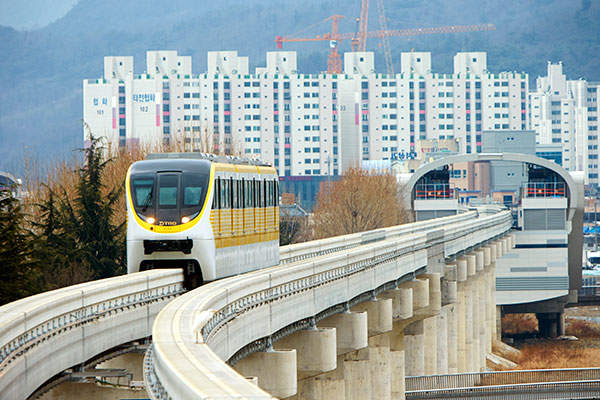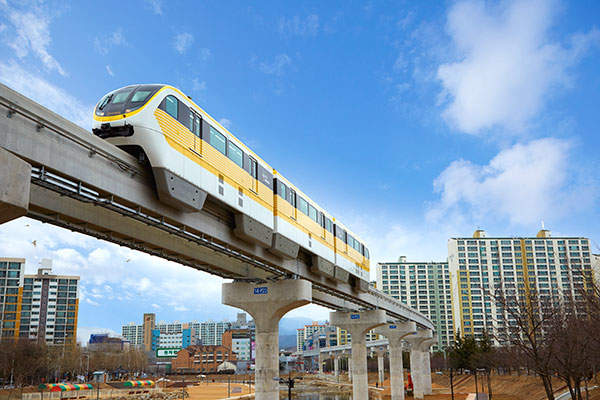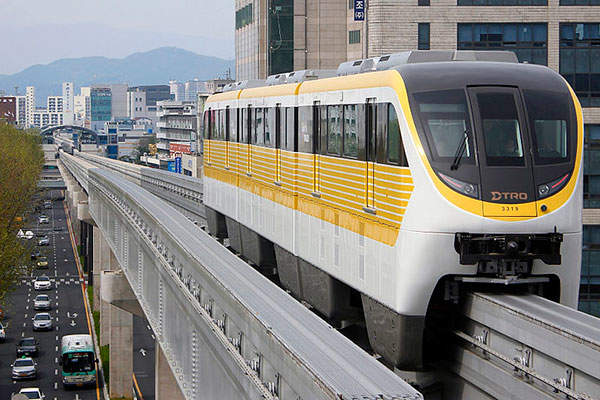Daegu Urban Railway Line 3, also called Sky Rail, is a 23.95km-long bidirectional monorail line of Daegu Metro, which serves Daegu, South Korea. The new system, which started service on 23 April 2015, is Korea’s first urban monorail transit system.
Construction of the straddle-type monorail system began in June 2009 and involved an investment of KRW858.8bn (approximately $792m).
Daegu Metropolitan City, the owner of the monorail system, entrusted the construction of the mass rapid transit system (MRTS) line to its subsidiary Urban Railroad Construction Headquarters. Daegu Metropolitan Transit Corporation is the operator of the system.
Daegu Urban Line 3 project details
Daegu Metro Line 3 is based on an automated railway system, which passes through the centre of the city while intersecting the other two lines 1 and 2. The line originates at KNU Medical Centre and ends at Yongji station, connecting the north-western and the south-eastern parts of Daegu.
The line includes 30 stations, two car depots and two special bridges (over Geumhogang River and Sincheon Stream). It is estimated to transport approximately 84 million passengers during the first operational year and is proposed to be extended by 4km by 2031.
The monorail is designed to operate as a digital ATP/ATO driverless system. The train movement, safety and operation on the new line are controlled by automatic train control system consisting of automatic train operation (ATO), automatic train protection (ATP), and automatic train supervision (ATS) systems.
Each carriage will be monitored using two closed-circuit surveillance cameras, with the images transmitted real-time to the central monitoring station.
Rolling stock for the Sky Rail
Unveiled in July 2013, a total of 28 Hitachi monorail train sets comprising 84 cars run on the monorail. Each monorail vehicle with three carriages is 15m-long, 2.9m-wide and 5.24m-high. It has a passenger capacity of 265 and can accommodate up to 398 passengers during the busiest hours.
The vehicles have a top speed of 70km/h, but run at an average speed of 30km/h on Line 3. The aluminium monorail body features driving, guiding and stabilising wheels that move the car along its orbit beam. An exterior skirt is placed around the guiding and stabilising wheels to reduce noise during operation.
Two special areas for wheelchairs and 21 seats for the elderly and disabled people, as well as pregnant women are reserved in the trains.
Mist-glass window technology in the passenger compartments is also introduced in the monorails. The windows feature liquid-crystal screens that automatically change from transparent to blind state as the monorail runs through residential neighbourhoods, ensuring privacy for people living along the line.
The Korea Rail Network Authority (KRNA) is developing the new 231km-long Honam high-speed railway (HSR) line from Osong to Mokpo.
The cars are installed with sprinkler-type fire extinguishers. Special emergency spiral chutes are also installed to help the passengers evacuate quickly in emergency situations. The safety system consists of devices such as emergency interphones and broadcasting equipment.
Daegu urban railway line 3 construction
Construction of the entire 1,316 pre-stressed concrete (PSC) track beams was completed by May 2013. The beams were transported to the site by large trailers consisting of 130 wheels.
Other major works involved the construction of the 30 stations, interiors, exteriors and exits. The works further included electrical supply, communications and signal facilities.
Contractors involved with Korea’s first urban monorail transit system
A consortium of POSCO E&C, GS Construction, Daewoo E&C, Hyundai E&C, SK E&C and Daelim was selected for the construction of the Daegu urban railway line 3.
Hitachi Transportation Systems Korea, a subsidiary of Hitachi, was contracted for the supply of monorail, track switches and signalling system for Korea’s first straddle-type monorail system.
In 2008, WOOJIN Industrial Systems signed a contract with Hitachi for the supply of monorails for the Daegu Line 3. Pyunghwa Engineering Consultants was engaged to provide construction supervision for Line 3.






